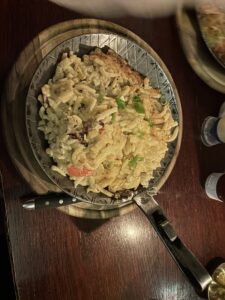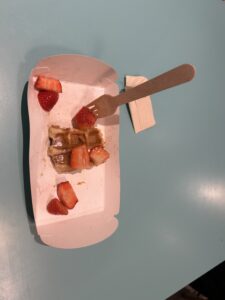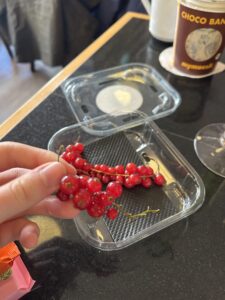Finding Good Food in Bonn is a Piece of Cake
Food is a large part of culture and community. While traveling, food is an important way to connect with the region’s traditions. I have enjoyed so much amazing food so far this semester. Access to certain foods is related to the infrastructure in certain regions. For instance, regional farms, transportation of goods through the area, and local grocery stores can all change how people can get food. In Bonn it is relatively easy to access fresh food as well as good restaurants with a variety of cuisines. One unexpected thing about finding food in Bonn is that almost everything is closed on Sundays. In the United States some shops might be shut down but large grocery stores stay open. Throughout my travels it has been cool to try traditional and local foods.
Food in Germany

The first day in Germany I was greeted by my host with a traditional German dish, maultaschen, for dinner. This delicious dish was made vegetarian and consisted of scrumptious chopped ravioli-like pasta with a spinach filling. It was cooked in a light tomato sauce with mushrooms. It was such a comforting meal and was an amazing way to start the semester. Since then I have had more amazing German food like Döner, which consists of warm pita around fresh vegetables and falafel or meat. The dish originates in Turkey and was brought to Germany through Turkish immigrants (Meurling, 2020). I also have eaten Spätzle, a traditional German pasta. I look forward to continuing to try German foods during the semester.
Food in Brussels

On my recent trip to Brussels a large portion of my time was spent eating fries, chocolate and waffles. These are all foods which are famously tied to the area. Fries were invented in Belgium in the Meuse region. Belgian chocolate and waffles came from preexisting recipes which were built upon by people in the area. Through enjoying the food I got a greater understanding of their culture, and what they take pride in.

In the United States finding vegetarian options can sometimes be difficult, though that has been changing in recent years. I have been happily surprised by how easy it has been to find delicious options for vegetarians and vegans both in restaurants and in grocery stores in Bonn. I often go to the marketplace in the center of Bonn which has affordable fresh produce along with food trucks. Also, on my travels throughout Europe I have had an easy time finding food that fits my dietary needs, which may in part be due to the fact we have mostly been in large cities.
Food is a part of intangible cultural heritage. The preparation, social customs and the foods themselves are intertwined with a region’s development and history (Evans, 2023). In the United States many staples come from immigrants who brought food with them, for instance pizza and tacos. The types of food available to create traditional dishes highly depended on the infrastructure surrounding an area. For example what local farms produced and if there was a major trade route nearby changed what people ate on a daily basis.
Having access to good, fresh and local food is very important for a community’s health and culture. I have been very grateful for the amazing food I have tried during this semester. It is easy to find good, delicious and fresh food in Bonn despite recent inflation. Food can say a lot about the culture, values, and history of a region.
Written by Maya M
References
Evans, S. (2023, July 19). Food as Culture: Cuisine, Food Customs, and Cultural Identity. SLO Food Bank. Retrieved February 15, 2025, from https://www.slofoodbank.org/food-as-culture/
Meurling, P. (2020, October 8). A Brief History of the Döner Kebap. Berlin Food Stories. Retrieved February 15, 2025, from https://berlinfoodstories.com/editorials/a-brief-history-of-the-doner-kebap
